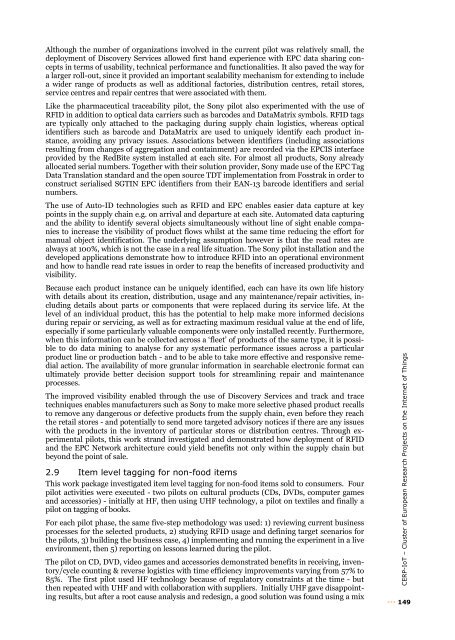Vision and Challenges for Realising the Internet of Things
Vision and Challenges for Realising the Internet of Things
Vision and Challenges for Realising the Internet of Things
You also want an ePaper? Increase the reach of your titles
YUMPU automatically turns print PDFs into web optimized ePapers that Google loves.
Although <strong>the</strong> number <strong>of</strong> organizations involved in <strong>the</strong> current pilot was relatively small, <strong>the</strong><br />
deployment <strong>of</strong> Discovery Services allowed first h<strong>and</strong> experience with EPC data sharing concepts<br />
in terms <strong>of</strong> usability, technical per<strong>for</strong>mance <strong>and</strong> functionalities. It also paved <strong>the</strong> way <strong>for</strong><br />
a larger roll-out, since it provided an important scalability mechanism <strong>for</strong> extending to include<br />
a wider range <strong>of</strong> products as well as additional factories, distribution centres, retail stores,<br />
service centres <strong>and</strong> repair centres that were associated with <strong>the</strong>m.<br />
Like <strong>the</strong> pharmaceutical traceability pilot, <strong>the</strong> Sony pilot also experimented with <strong>the</strong> use <strong>of</strong><br />
RFID in addition to optical data carriers such as barcodes <strong>and</strong> DataMatrix symbols. RFID tags<br />
are typically only attached to <strong>the</strong> packaging during supply chain logistics, whereas optical<br />
identifiers such as barcode <strong>and</strong> DataMatrix are used to uniquely identify each product instance,<br />
avoiding any privacy issues. Associations between identifiers (including associations<br />
resulting from changes <strong>of</strong> aggregation <strong>and</strong> containment) are recorded via <strong>the</strong> EPCIS interface<br />
provided by <strong>the</strong> RedBite system installed at each site. For almost all products, Sony already<br />
allocated serial numbers. Toge<strong>the</strong>r with <strong>the</strong>ir solution provider, Sony made use <strong>of</strong> <strong>the</strong> EPC Tag<br />
Data Translation st<strong>and</strong>ard <strong>and</strong> <strong>the</strong> open source TDT implementation from Fosstrak in order to<br />
construct serialised SGTIN EPC identifiers from <strong>the</strong>ir EAN-13 barcode identifiers <strong>and</strong> serial<br />
numbers.<br />
The use <strong>of</strong> Auto-ID technologies such as RFID <strong>and</strong> EPC enables easier data capture at key<br />
points in <strong>the</strong> supply chain e.g. on arrival <strong>and</strong> departure at each site. Automated data capturing<br />
<strong>and</strong> <strong>the</strong> ability to identify several objects simultaneously without line <strong>of</strong> sight enable companies<br />
to increase <strong>the</strong> visibility <strong>of</strong> product flows whilst at <strong>the</strong> same time reducing <strong>the</strong> ef<strong>for</strong>t <strong>for</strong><br />
manual object identification. The underlying assumption however is that <strong>the</strong> read rates are<br />
always at 100%, which is not <strong>the</strong> case in a real life situation. The Sony pilot installation <strong>and</strong> <strong>the</strong><br />
developed applications demonstrate how to introduce RFID into an operational environment<br />
<strong>and</strong> how to h<strong>and</strong>le read rate issues in order to reap <strong>the</strong> benefits <strong>of</strong> increased productivity <strong>and</strong><br />
visibility.<br />
Because each product instance can be uniquely identified, each can have its own life history<br />
with details about its creation, distribution, usage <strong>and</strong> any maintenance/repair activities, including<br />
details about parts or components that were replaced during its service life. At <strong>the</strong><br />
level <strong>of</strong> an individual product, this has <strong>the</strong> potential to help make more in<strong>for</strong>med decisions<br />
during repair or servicing, as well as <strong>for</strong> extracting maximum residual value at <strong>the</strong> end <strong>of</strong> life,<br />
especially if some particularly valuable components were only installed recently. Fur<strong>the</strong>rmore,<br />
when this in<strong>for</strong>mation can be collected across a ‘fleet’ <strong>of</strong> products <strong>of</strong> <strong>the</strong> same type, it is possible<br />
to do data mining to analyse <strong>for</strong> any systematic per<strong>for</strong>mance issues across a particular<br />
product line or production batch - <strong>and</strong> to be able to take more effective <strong>and</strong> responsive remedial<br />
action. The availability <strong>of</strong> more granular in<strong>for</strong>mation in searchable electronic <strong>for</strong>mat can<br />
ultimately provide better decision support tools <strong>for</strong> streamlining repair <strong>and</strong> maintenance<br />
processes.<br />
The improved visibility enabled through <strong>the</strong> use <strong>of</strong> Discovery Services <strong>and</strong> track <strong>and</strong> trace<br />
techniques enables manufacturers such as Sony to make more selective phased product recalls<br />
to remove any dangerous or defective products from <strong>the</strong> supply chain, even be<strong>for</strong>e <strong>the</strong>y reach<br />
<strong>the</strong> retail stores - <strong>and</strong> potentially to send more targeted advisory notices if <strong>the</strong>re are any issues<br />
with <strong>the</strong> products in <strong>the</strong> inventory <strong>of</strong> particular stores or distribution centres. Through experimental<br />
pilots, this work str<strong>and</strong> investigated <strong>and</strong> demonstrated how deployment <strong>of</strong> RFID<br />
<strong>and</strong> <strong>the</strong> EPC Network architecture could yield benefits not only within <strong>the</strong> supply chain but<br />
beyond <strong>the</strong> point <strong>of</strong> sale.<br />
2.9 Item level tagging <strong>for</strong> non-food items<br />
This work package investigated item level tagging <strong>for</strong> non-food items sold to consumers. Four<br />
pilot activities were executed - two pilots on cultural products (CDs, DVDs, computer games<br />
<strong>and</strong> accessories) - initially at HF, <strong>the</strong>n using UHF technology, a pilot on textiles <strong>and</strong> finally a<br />
pilot on tagging <strong>of</strong> books.<br />
For each pilot phase, <strong>the</strong> same five-step methodology was used: 1) reviewing current business<br />
processes <strong>for</strong> <strong>the</strong> selected products, 2) studying RFID usage <strong>and</strong> defining target scenarios <strong>for</strong><br />
<strong>the</strong> pilots, 3) building <strong>the</strong> business case, 4) implementing <strong>and</strong> running <strong>the</strong> experiment in a live<br />
environment, <strong>the</strong>n 5) reporting on lessons learned during <strong>the</strong> pilot.<br />
The pilot on CD, DVD, video games <strong>and</strong> accessories demonstrated benefits in receiving, inventory/cycle<br />
counting & reverse logistics with time efficiency improvements varying from 57% to<br />
85%. The first pilot used HF technology because <strong>of</strong> regulatory constraints at <strong>the</strong> time - but<br />
<strong>the</strong>n repeated with UHF <strong>and</strong> with collaboration with suppliers. Initially UHF gave disappointing<br />
results, but after a root cause analysis <strong>and</strong> redesign, a good solution was found using a mix<br />
CERP-IoT – Cluster <strong>of</strong> European Research Projects on <strong>the</strong> <strong>Internet</strong> <strong>of</strong> <strong>Things</strong><br />
149
















